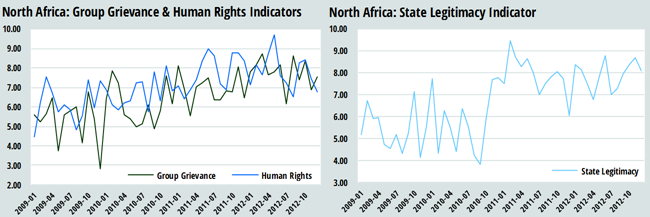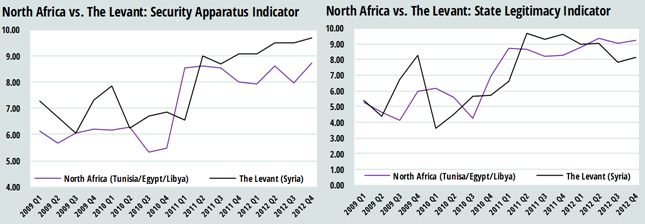BY NATE HAKEN
Does state failure matter? Obviously it matters mostly for the population of that country, but even for its neighbors, the answer is a resounding yes. Chaos in a single country can often impact an entire region.
In 2011, as measured in the 2012 FSI, Tunisia and the wider “Arab Spring” were the case in point. In 2012, Mali — the most worsened state in the 2013 FSI — dragged the Western Sahel into a vortex of instability. Though neither Tunisia nor Mali were among the countries most at risk as measured by the FSI, when the social, economic, political, and security pressures spiked in those countries and the states convulsed, it would eventually affect others in the region. Underscoring the point, what happened in Mali this year actually started in Tunisia two years prior.
Since 2011, debates have raged about the Arab Spring. Observers have sought to identify root causes, proximate causes, and triggers, positing various combinations of factors like corruption, food prices, poverty, median age, youth unemployment, and social media. Countless pundits have opined on the short, medium, and long term implications: good, bad, or neutral for democracy, human rights, or national and regional stability – or more parochially, for American national interests and security. Such questions, of course, do not have simple answers, except perhaps in hyper-partisan discourse.
Though it is difficult to make definitive pronouncements about what it all might mean in the long-term, we can with some degree of confidence describe what happened. This is possible using holistic analytical frameworks like CAST, upon which the Failed States Index is based. For the FSI, CAST triangulates data from pre-existing data sets, qualitative review, and original data generated through content analysis of millions of media reports using search strings and algorithms. Each of the three methods has its strengths and weaknesses. Content analysis is particularly strong in its ability to track trends in dynamic indicators at varying levels of spatial-temporal granularity, a helpful feature when attempting to analyze complex systems, which underlie the pathology of state failure in rapidly changing environments.

Drilling into the content analysis data, CAST tells the story of a storm birthed in North Africa, which had been brewing for some time. In 2009, the international community had not considered the potential impact of massive protests and popular uprisings sweeping across borders and governments in North Africa. But the CAST indicators for Group Grievance and Human Rights were gradually and inexorably getting worse. In November 2010, there was a dramatic regional increase in the State Legitimacy score (based on a regional average) that has yet to come back down. A month later, thousands took to the streets in Tunisia, taking the world by surprise. This is not to say that CAST could have predicted the Arab Spring — but the trends were there to be seen.
In 2011 and 2012, the storm twisted east through the Arabian Peninsula and the Levant, and south through the Western Sahel region of Mali, Mauritania, and Niger, taking on different forms and patterns along the way. From the Sahel to the Levant, the storm manifested itself variously as popular, peaceful protest leading to political reform (Morocco), peaceful revolution (Egypt), violent revolution (Libya), and protracted civil war (Syria). Governments that tried to cling to the status quo were fighting a losing battle. This storm was too big to manage without reforms.
Patterns and Trends
Mapping the storm over time and space, and the sequence of indicators as they spiked in successive waves, both the long term trends and sudden volatility indicated the scope of the challenge. In Tunisia where it all started, a group of CAST indicators spiked in October of 2009, based on content analysis of media reports at the time, when then-President Ben Ali won a fifth term in office in flawed elections. In November 2010, pressures began to spike again dramatically a month before a man named Mohamed Bouazizi set himself on fire and ignited a revolution.

Along with Tunisia, State Legitimacy was worsening in the fourth quarter of 2010 in Libya and Egypt as well. Trailing the State Legitimacy score by three months, pressures on the Security Apparatus manifested as security forces responded to massive protests using varying degrees of repressive force.
The storm then spun into Syria, which lagged behind the North African countries by about three months.
Turning South
Now, waves of instability have moved south from North Africa to the Western Sahel region. According to the UN Security Council’s Group of Experts, weapons from the 2011 civil war in Libya moved rapidly throughout the region, particularly Chad, Niger, and into Mali where January 2012 attacks in the North drove refugees into Mauritania. In April-May 2012, rebels declared independence in the northern part of Mali, and refugees and fighters from Mali crossed porous borders into neighboring countries. Forces were drawn in from abroad to fight on both sides, regionalizing the impacts of the conflict.
Given this fact, it is perhaps not surprising that as measured by content analysis, there was an unmistakable echo of Mali’s indicator scores in countries throughout the region, particularly Niger, Mauritania, and Burkina Faso where there was an increased number of refugees and border disputes. Even as far south as Nigeria, militants from the Jama’atu Ahlus-Sunnah Lidda’Awati Wal Jihad (known as Boko Haram) have reportedly fled to Mali for training and safe haven. As counterinsurgency escalates in the northeastern part of Nigeria, refugees are fleeing north into the neighboring country Niger, where the United States has begun setting up a base from which unarmed Predator drones can conduct surveillance over the Sahel region.
When states fail they don’t fall alone; they pull neighbors into their wake. This is nothing new; when the Berlin Wall fell in 1989, it was a “Spring” of sorts for democracy but it did lead to paroxysms across former Soviet bloc countries and Yugoslavia as the balance of power was suddenly upended, patronage dried up, and populations were displaced. As the world becomes increasingly interdependent, promotion of sustainable human security requires more collaboration at every level, including those in the public, private, and nongovernmental sectors. In a place like the Sahel, drones and counterinsurgency will not solve the longer-term challenges. The long-term problems will not be solved from the top down, particularly as the international community wearies of state building.
Short term security and humanitarian emergencies can perhaps be addressed on an ad hoc basis at mounting cost as the world pivots from crisis to crisis. But for better or worse, state building is the only solution in the end, which is why holistic frameworks and dynamic data analysis of risk factors at the regional, national, and local levels are critical. The process of data gathering and analysis must be owned, with the support of the international community, by local civil society so that they can actively use the information to promote reconciliation, improved governance, increased public services, and infrastructure development. Effective collaboration requires shared information on compatible platforms so that data can be meaningfully integrated, cross-validated, and analyzed. More important than good data and analysis, is the application of that information by a broad group of stakeholders, from local to international and from public to private, to use it in a collaborative way for building practical and sustainable conflict mitigation and peace building strategies.